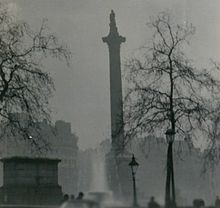I wonder how many newspapers this week will comment on the sixtieth anniversary of the great London smog, which occurred between 4-9 December 1952, and killed an estimated 12,000 people. I’m sure some publications will have ‘From the Archives’ sections or the equivalent, which discusses it. In addition the fact it lasted for several days means the anniversary is spread out so it is harder to say ‘On this day 60 years ago…’. Yet this was a major disaster, even if it only affected London, and led to the Beaver Committee being established which led eventually to the Clean Air Act of 1956. Following this, other cities which had been plagued by air pollution began to act to clean their local environs of air pollution.

Picture of Nelson’s Column in smog, taken from Wikipedia – http://en.wikipedia.org/wiki/Great_smog
Most of the literature at the time, and since, about the smog has been the effect it had on people’s health, which was grave, with the numbers who died not just during the week but in the days, weeks and months later. There is also, however, a small section which mentions the effect air pollution in general had on the environment. The Socialist Medical Association (now the Socialist Health Association) even produced a leaflet about air pollution – ‘Death in the Air! The menace of air pollution’. Dated around c.1956, this leaflet, brochure, whatever it was mentions specifically the environment effects of air pollution (the effect on plants and animals). All the more surprising, considering it came from a medical organisation.
There is a lack of environmental-analysis on the smog (and clean air), most discussion coming from the point of view of air pollution and its effects on human health. Understandable. Yet there was discussion about the environment at least in some quarters. The result of the smog – the eventual passing of the Clean Air Act of 1956, led to other cities in Britain controlling smoke and imposing clean air zones. Whilst the Clean Air Act did not immediately get rid of all smog, it did begin to ensure that air pollution was controlled more. And led people to think about what fuel they burnt, as part of the problem had been the low temperatures and households burning coal (as well as pollution from industry).
A weather system settled over London in early December 1952, creating fog and reducing the temperatures. Industry continued to bleech pollution into the air and the fall in temperature caused homes to use their coal fires to keep warm, creating more pollution. The still air reduced visibility to near zero, it aggrevated people’s lungs who breathed in the thick air, many who had previously been healthy, and people could not see their feet. One person has even described as following a bus in the smog and the bus driving up someone’s drive, having got lost where the road was.
Not everyone died that week; it was in the weeks and months following that some deaths came, although many people were admitted to hospital during the week the smog was present. What is significant is the effects it had – with the Beaver Committee and the Clean Air Act and on cities across the country to control their air pollution problems. To quote Wikipedia – “The death toll formed an important impetus to modern environmentalism, and it caused a rethinking of air pollution, as the smog had demonstrated its lethal potential.”
Wikipedia article on the smog – http://en.wikipedia.org/wiki/Great_smog
Update (December 2013): I wrote a short blog post about this topic, linking it with current air pollution problems in China and other countries, here.



Pingback: London’s Great Smog, 60 Years On
Pingback: London’s Great Smog, 60 Years On | Jim Clifford